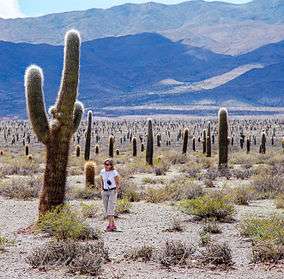National park

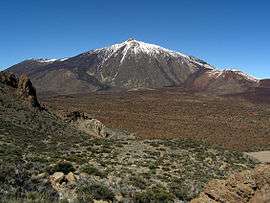
A national park is a park in use for conservation purposes. Often it is a reserve of natural, semi-natural, or developed land that a sovereign state declares or owns. Although individual nations designate their own national parks differently, there is a common idea: the conservation of 'wild nature' for posterity and as a symbol of national pride.[1] An international organization, the International Union for Conservation of Nature (IUCN), and its World Commission on Protected Areas, has defined "National Park" as its Category II type of protected areas.
While this type of national park had been proposed previously, the United States established the first "public park or pleasuring-ground for the benefit and enjoyment of the people", Yellowstone National Park, in 1872.[2] Although Yellowstone was not officially termed a "national park" in its establishing law, it was always termed such in practice[3] and is widely held to be the first and oldest national park in the world. The first area to use "national park" in its creation legislation was the US's Mackinac Island, in 1875. Australia's Royal National Park, established in 1879, was the world's third official national park.[4] In 1895 ownership of Mackinac Island was transferred to the State of Michigan as a state park and national park status was consequently lost.[5] As a result, Australia's Royal National Park is by some considerations the second oldest national park now in existence.[5][6][7]
The largest national park in the world meeting the IUCN definition is the Northeast Greenland National Park, which was established in 1974. According to the IUCN, 6,555 national parks worldwide met its criteria in 2006. IUCN is still discussing the parameters of defining a national park.[8]
National parks are almost always open to visitors.[9] Most national parks provide outdoor recreation and camping opportunities as well as classes designed to educate the public on the importance of conservation and the natural wonders of the land in which the national park is located.
Definitions
In 1969, the IUCN declared a national park to be a relatively large area with the following defining characteristics:[11]
- One or several ecosystems not materially altered by human exploitation and occupation, where plant and animal species, geomorphological sites and habitats are of special scientific, educational, and recreational interest or which contain a natural landscape of great beauty;
- Highest competent authority of the country has taken steps to prevent or eliminate exploitation or occupation as soon as possible in the whole area and to effectively enforce the respect of ecological, geomorphological, or aesthetic features which have led to its establishment; and
- Visitors are allowed to enter, under special conditions, for inspirational, educative, cultural, and recreative purposes.
In 1971, these criteria were further expanded upon leading to more clear and defined benchmarks to evaluate a national park. These include:
- Minimum size of 1,000 hectares within zones in which protection of nature takes precedence
- Statutory legal protection
- Budget and staff sufficient to provide sufficient effective protection
- Prohibition of exploitation of natural resources (including the development of dams) qualified by such activities as sport, fishing, the need for management, facilities, etc.
While the term national park is now defined by the IUCN, many protected areas in many countries are called national park even when they correspond to other categories of the IUCN Protected Area Management Definition, for example:[9][12]
- Swiss National Park, Switzerland: IUCN Ia - Strict Nature Reserve
- Everglades National Park, United States: IUCN Ib - Wilderness Area
- Białowieża National Park, Poland: IUCN II National Park
- Victoria Falls National Park, Zimbabwe: IUCN III - National Monument
- Vitosha National Park, Bulgaria: IUCN IV - Habitat Management Area
- New Forest National Park, United Kingdom: IUCN V - Protected Landscape
- Etniko Ygrotopiko Parko Delta Evrou, Greece: IUCN VI - Managed Resource Protected Area
While national parks are generally understood to be administered by national governments (hence the name), in Australia national parks are run by state governments and predate the Federation of Australia; similarly, national parks in the Netherlands are administered by the provinces.[9] In many countries, including Indonesia, the Netherlands, and the United Kingdom, national parks do not adhere to the IUCN definition, while some areas which adhere to the IUCN definition are not designated as national parks.[9]
History
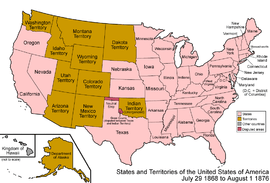
In 1810, the English poet William Wordsworth described the Lake District as a[13]
sort of national property, in which every man has a right and interest who has an eye to perceive and a heart to enjoy.
The painter George Catlin, in his travels through the American West, wrote during the 1830s that the Native Americans in the United States might be preserved[14]
(by some great protecting policy of government) ...in a magnificent park ...A nation's Park, containing man and beast, in all the wild and freshness of their nature's beauty!
The first effort by the Federal government to set aside such protected lands was on April 20, 1832, when President Andrew Jackson signed legislation that the 22nd United States Congress had enacted to set aside four sections of land around what is now Hot Springs, Arkansas, to protect the natural, thermal springs and adjoining mountainsides for the future disposal of the U.S. government.[15][16][17] It was known as Hot Springs Reservation, but no legal authority was established. Federal control of the area was not clearly established until 1877.[15]

John Muir is today referred to as the "Father of the National Parks" due to his work in Yosemite.[18] He published two influential articles in The Century Magazine, which formed the base for the subsequent legislation.[19][20]
President Abraham Lincoln signed an Act of Congress on July 1, 1864, ceding the Yosemite Valley and the Mariposa Grove of Giant Sequoias (later becoming Yosemite National Park) to the state of California. According to this bill, private ownership of the land in this area was no longer possible. The state of California was designated to manage the park for "public use, resort, and recreation". Leases were permitted for up to ten years and the proceeds were to be used for conservation and improvement. A public discussion followed this first legislation of its kind and there was a heated debate over whether the government had the right to create parks. The perceived mismanagement of Yosemite by the Californian state was the reason why Yellowstone at its establishment six years later was put under national control.[21][22]
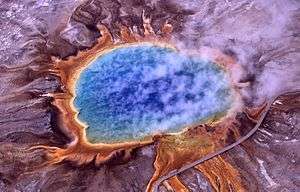
In 1872, Yellowstone National Park was established as the United States' first national park,[23] being also the world's first national park. In some European countries, however, national protection and nature reserves already existed, such as Drachenfels (Germany, 1822) and a part of Forest of Fontainebleau (France, 1861).[24]
Yellowstone was part of a federally governed territory. With no state government that could assume stewardship of the land so the federal government took on direct responsibility for the park, the official first national park of the United States. The combined effort and interest of conservationists, politicians and the Northern Pacific Railroad ensured the passage of enabling legislation by the United States Congress to create Yellowstone National Park. Theodore Roosevelt, already an active campaigner and so influential, as good stump speakers were highly necessary in the pre-telecommunications era, was highly influential in convincing fellow Republicans and big business to back the bill.
American Pulitzer Prize-winning author Wallace Stegner wrote:[25]
National parks are the best idea we ever had. Absolutely American, absolutely democratic, they reflect us at our best rather than our worst.
In his book Dispossessing the Wilderness: Indian Removal and the Making of the National Parks, Mark David Spence made the point that in order to create these uninhabited spaces, the United States first had to disposess the Indians who were living in them.[26]
Even with the creation of Yellowstone, Yosemite, and nearly 37 other national parks and monuments, another 44 years passed before an agency was created in the United States to administer these units in a comprehensive way – the U.S. National Park Service (NPS). The 64th United States Congress passed the National Park Service Organic Act, which President Woodrow Wilson signed into law on August 25, 1916. Of the 413 sites managed by the National Park Service of the United States, only 59 carry the designation of National Park.
Following the idea established in Yellowstone, there soon followed parks in other nations. In Australia, the Royal National Park was established just south of Sydney on April 26, 1879, becoming the world's second official national park[27] (actually the 3rd: Mackinac National Park in Michigan was created in 1875 as a national park but was later transferred to the state's authority in 1895, thus losing its official "national park" status).[28] Rocky Mountain National Park became Canada's first national park in 1885. Argentina became the third country in the Americas to create a national park system, with the creation of the Nahuel Huapi National Park in 1934, through the initiative of Francisco Moreno. New Zealand established Tongariro National Park in 1887. In Europe, the first national parks were a set of nine parks in Sweden in 1909, followed by the Swiss National Park in 1914. Europe has some 359 national parks as of 2010. Africa's first national park was established in 1925 when Albert I of Belgium designated an area of what is now Democratic Republic of Congo centred on the Virunga Mountains as the Albert National Park (since renamed Virunga National Park). In 1973, Mount Kilimanjaro was classified as a National Park and was opened to public access in 1977.[29] In 1926, the government of South Africa designated Kruger National Park as the nation's first national park, although it was an expansion of the earlier Sabie Game Reserve established in 1898 by President Paul Kruger of the old South African Republic, after whom the park was named. After World War II, national parks were founded all over the world. The Vanoise National Park in the Alps was the first French national park, created in 1963 after public mobilization against a touristic project.
The world's first national park service was established May 19, 1911, in Canada.[30] The Dominion Forest Reserves and Parks Act placed the dominion parks under the administration of the Dominion Park Branch (now Parks Canada). The branch was established to "protect sites of natural wonder" to provide a recreational experience, centered on the idea of the natural world providing rest and spiritual renewal from the urban setting.[31] Canada now has the largest protected area in the world with 377,000 km² of national park space.[32] In 1989, the Qomolangma National Nature Preserve (QNNP) was created to protect 3.381 million hectares on the north slope of Mount Everest in the Tibet Autonomous Region of China. This national park is the first major global park to have no separate warden and protection staff—all of its management being done through existing local authorities, allowing a lower cost basis and a larger geographical coverage (in 1989 when created, it was the largest protected area in Asia). It includes four of the six highest mountains Everest, Lhotse, Makalu, and Cho Oyu. The QNNP is contiguous to four Nepali national parks, creating a transborder conservation area equal in size to Switzerland.[33]
- National parks
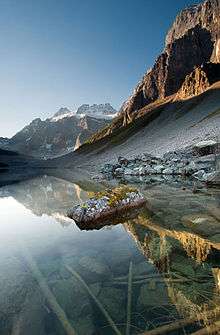 Lower Consolation Lake in Banff National Park, Alberta, Canada
Lower Consolation Lake in Banff National Park, Alberta, Canada Hadrian's Wall crosses Northumberland National Park in England
Hadrian's Wall crosses Northumberland National Park in England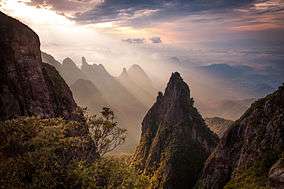 Serra dos Órgãos National Park in Rio de Janeiro state, Brazil. This national park is one of the few natural habitats of species of Schlumbergera[34]
Serra dos Órgãos National Park in Rio de Janeiro state, Brazil. This national park is one of the few natural habitats of species of Schlumbergera[34]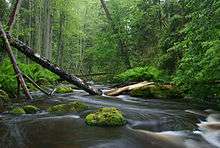 Lahemaa National Park in Estonia was the first area to be designated a national park in the former Soviet Union
Lahemaa National Park in Estonia was the first area to be designated a national park in the former Soviet Union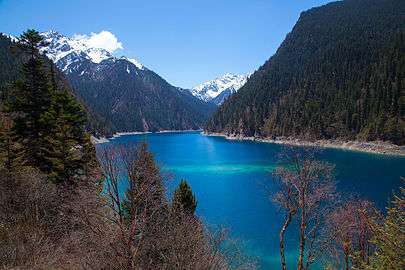 Jiuzhaigou in China is a national park known for its many multi-level waterfalls, colorful lakes, and snow-capped peaks.
Jiuzhaigou in China is a national park known for its many multi-level waterfalls, colorful lakes, and snow-capped peaks. Deosai National Park in Pakistan is known for being one of the highest plains in the world with serene beauty and wildlife.
Deosai National Park in Pakistan is known for being one of the highest plains in the world with serene beauty and wildlife.
Economic ramifications
Countries with a large nature-based tourism industry, such as Costa Rica, often experience a huge economic effect on park management as well as the economy of the country as a whole.[35]
Tourism
Tourism to national parks has increased considerably over time. In Costa Rica for example, a megadiverse country, tourism to parks has increased by 400% from 1985 to 1999.[35] The term national park is perceived as a brand name that is associated with nature-based tourism and it symbolizes "high quality natural environment and well-design tourism infrastructure".[36]
Staff
The duties of a park ranger are to supervise, manage, and/or perform work in the conservation and use of Federal park resources. This involves functions such as park conservation; natural, historical, and cultural resource management; and the development and operation of interpretive and recreational programs for the benefit of the visiting public. Park rangers also have fire fighting responsibilities and execute search and rescue missions. Activities also include heritage interpretation to disseminate information to visitors of general, historical, or scientific information. Management of resources such as wildlife, lakeshores, seashores, forests, historic buildings, battlefields, archeological properties, and recreation areas are also part of the job of a park ranger.[37] Since the establishment of the National Park Service in the US in 1916, the role of the park ranger has shifted from merely being a custodian of natural resources to include several activities that are associated with law enforcement.[38] They control traffic and investigate violations, complaints, trespass/encroachment, and accidents.[37]
See also
- Conservation ecology
- Conservation movement
- Federal lands – in the United States
- Fossil park
- Global Geoparks Network
- International Park
- List of national parks – by country
- Lists of tourist attractions
- National monument – in the United States
- National Park Foundation
- National Park Travelers Club
- National Parks Conservation Association
- Provincial park
- State park
- Sustainable development
- The National Parks: America's Best Idea
- United Nations Environment Programme
- World Database on Protected Areas
References
Citations
- ↑ Europarc Federation (eds.) 2009, Living Parks, 100 Years of National Parks in Europe, Oekom Verlag, München
- ↑ The Act
- ↑ Report of the Superintendent of Yellowstone National Park for the Year 1872, 43rd Congress, 3rd Session, ex. doc. 35, quoting Department of Interior letter of May 10, 1872, "The reservation so set apart is to be known as the "Yellowstone National Park"."
- ↑ "National parks". Department of Communications, Information Technology and the Arts. Australian Government. 31 July 2007. Retrieved 2 November 2014.
- 1 2 Kim Allen Scott, 2011 "Robertson's Echo The Conservation Ethic in the Establishment of Yellowstone and Royal National Parks" Yellowstone Science 19:3
- ↑ "Audley Bottom". Pinkava.asu.edu. Retrieved 3 November 2014.
- ↑ Rodney Harrison, 2012 "Heritage: Critical approaches" Routledge
- ↑ "History of the National Parks". Association of National Park Authorities. Retrieved 12 November 2012.
- 1 2 3 4 Gissibl, B., S. Höhler and P. Kupper, 2012, Civilizing Nature, National Parks in Global Historical Perspective, Berghahn, Oxford
- ↑ Jane Levere (29 August 2011). "The World's Most Beautiful National Parks". Forbes. Retrieved 2011-10-04.
- ↑ Gulez, Sumer (1992). A method of evaluating areas for national park status.
- ↑ European Environment Agency Protected areas in Europe – an overview In: EEA Report No 5/2012 Kopenhagen: 2012 ISBN 978-92-9213-329-0 ISSN 1725-9177 pdf doi=10.2800/55955
- ↑ Wordsworth, William (1835). A guide through the district of the lakes in the north of England with a description of the scenery, &c. for the use of tourists and residents (5th ed.). Kendal, England: Hudson and Nicholson. p. 88.
- ↑ Catlin, George (1841). Letters and Notes on the manners, customs, and condition of the North American Indians: written during eight years' travel amongst the wildest tribes of Indians in North America in 1832, 33, 34, 35, 36, 37, 38, and 39. 1. Egyptian Hall, Piccadilly, London: Published by the author. pp. 261–262.
- 1 2 Shugart, Sharon (2004). "Hot Springs of Arkansas Through the Years: A Chronology of Events" (PDF). National Park Service. Retrieved 2008-03-30.
- ↑ Peters, Richard, ed. (1866). "Twenty-Second Congress, Session 1, Chap. 70: An Act authorizing the governor of the territory of Arkansas to lease the salt springs, in said territory, and for other purposes (April 20, 1832)" (PDF). The Public Statutes at Large of the United States of America from the Organization of the Government in 1789, to March 3, 1845, Treaties, and Proclamations of the United States of America from December 1863, to December 1865. 4. Boston: Charles C. Little and James Brown. p. 505.
- ↑ "Act Establishing Yellowstone National Park (1872)". Our Documents.gov. Retrieved 9 January 2016.
- ↑ Miller, Barbara Kiely (2008). John Muir. Gareth Stevens. p. 10. ISBN 0836883187.
- ↑ John Muir. "Features of the Proposed Yosemite National Park" The Century Magazine, Vol. XL. September 1890. No. 5
- ↑ John Muir. "The Treasures of the Yosemite" The Century Magazine, Vol. XL. August 1890. No. 4
- ↑ Adam Wesley Dean. Natural Glory in the Midst of War: The Establishment of Yosemite State Park In: Abstract. Civil War History Volume 56, Number 4, December 2010 pp. 386-419 | 10.1353/cwh.2010.0008
- ↑ Sanger, George P., ed. (1866). "Thirty-Eighth Congress, Session 1, Chap. 184: An Act authorizing a Grant to the State of California of the "Yo-Semite Valley" and of the Land embracing the "Mariposa Big Tree Grove" (June 30, 1864)" (PDF). 38th United States Congress, Session 1, 1864. In: The Statutes at Large, Treaties, and Proclamations of the United States of America from December 1863, to December 1865. 13. Boston: Little, Brown and Company. p. 325.
- ↑ Mangan, Elizabeth U. Yellowstone, the First National Park from Mapping the National Parks. Library of Congress, Geography and Map Division.
- ↑ Kimberly A. Jones, Simon R. Kelly, Sarah Kennel, Helga Kessler-Aurisch, In the forest of Fontainebleau: painters and photographers from Corot to Monet, National Gallery of Art, 2008, p.23
- ↑ "Famous Quotes Concerning the National Parks: Wallace Stegner, 1983". Discover History. National Park Service. 2003-01-16. Retrieved 2011-10-24.
- ↑ Dispossessing the Wilderness: Indian Removal and the Making of the National Parks. New York and Oxford: Oxford University Press, 1999 : Review by Colin Fisher, H-Environment, August 2000
- ↑ "1879: Australia's first national park created". National Museum of Australia. Retrieved 9 January 2016.
- ↑ "Mackinac Island". Michigan State Housing Development Authority. Retrieved 9 January 2016.
- ↑ "Kilimanjaro: The National Park". Private Kilimanjaro: About Kilimanjaro. Private Expeditions, Ltd. 2011. Retrieved 2011-10-24.
- ↑ Irish, Paul (May 13, 2011). "Parks Canada celebrates a century of discovery". Toronto Star. Retrieved May 18, 2011.
- ↑ "Parks Canada History". Parks Canada. February 2, 2009. Retrieved August 30, 2012.
- ↑ "Parks Canada". Parks Canada. Retrieved August 30, 2012.
- ↑ Daniel C. Taylor, Carl E. Taylor, Jesse O. Taylor, Empowerment on an Unstable Planet New York & Oxford: Oxford University Press, 2012, Chapter 9
- ↑ McMillan, A.J.S.; Horobin, J.F. (1995), Christmas Cacti : The genus Schlumbergera and its hybrids (p/b ed.), Sherbourne, Dorset: David Hunt, ISBN 978-0-9517234-6-3
- 1 2 Eagles, Paul F.J. "Trends in Park Tourism: Economics, Finance and Management". In: Journal of Sustainable Tourism Volume 10, Issue 2, 2002, p. 134. Doi:10.1080/09669580208667158
- ↑ Eagles, Paul F.J. "Trends in Park Tourism: Economics, Finance and Management". In: Journal of Sustainable Tourism Volume 10, Issue 2, 2002, p. 133. Doi:10.1080/09669580208667158
- 1 2 U.S. Office of Personnel Management. Handbook of occupational groups and families. Washington, D.C. January 2008. Page 19. OPM.gov Accessed November 2, 2014.
- ↑ R Meadows ; D L Soden In: National Park Ranger Attitudes and Perceptions Regarding Law Enforcement Issues. Abstract. Justice Professional Volume:3 Issue:1 (Spring 1988) Pages:70-93
Sources
- Eagles, Paul F. J; McCool, Stephen F. (2002). Tourism in National Parks and Protected Areas: Planning and Management. CABI. ISBN 0851997597. 320 pages.
- Sellars, Richard West (2009). Preserving Nature in the National Parks: A History. Yale University Press. ISBN 0300154143. 404 pages.
- Sheail, John (2010) Nature's Spectacle - The World's First National Parks and Protected Places Earthscan, London, Washington. ISBN 978-1-84971-129-6
External links
- U.S. National Park Service FAQs
- Protected Planet – World Database of Protected Areas
- UNESCO — Man and the Biosphere Programme (Biosphere Reserves)
- World Heritage Sites
- A-Z of Areas of Biodiversity Importance: National Parks
- World Database on Protected Areas
- EUROPARC Federation — Europe's protected areas
- National Parks Worldwide
- National parks, landscape parks and protected areas in the world
